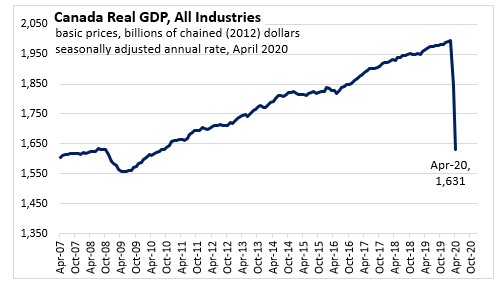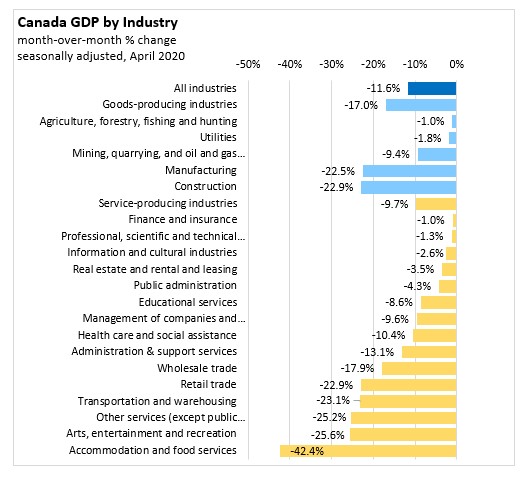The Economics and Statistics Division maintains archives of previous publications for accountability purposes, but makes no updates to keep these documents current with the latest data revisions from Statistics Canada. As a result, information in older documents may not be accurate. Please exercise caution when referring to older documents. For the latest information and historical data, please contact the individual listed to the right.
<--- Return to Archive
For additional information relating to this article, please contact:
June 30, 2020CANADA GDP BY INDUSTRY, APRIL 2020 Real GDP in Canada declined 11.6 per cent month over month in April 2020, following a 7.5 per cent decline in March. With all 20 industrial sectors of the economy down, this was the largest monthly decline since the series started in 1961.
April 2020 marked the first full month of social distancing measures put in place to slow the spread of COVID-19, and the economy in April was 18.2 per cent below its February 2020 level, the month before the COVID-19 measures began.
Compared to April 2019, the Canadian economy contracted 17.1 per cent with an annualized value of $1,631 billion (chained 2012 dollars) in April 2020.


Goods-Producing Industries
Output for goods-producing sector decline 17.0 per cent in April 2020 as all subsectors contracted. Construction declined 22.9 per cent in April 2020 led by a decline in non-residential construction (-36.0%). Engineering construction (-17.2%) and repair construction (-25.4%) were also down in April 2020.
The manufacturing sector was down 22.5 per cent in April 2020 as many factories were either completely shut down or operated at a much lower capacity in response to local and provincial emergency measures put in place.
Durable manufacturing declined 29.2 per cent, mainly due to a 49.6 per cent drop in transportation equipment manufacturing. As a result of the continued closure of automotive plants both in Canada and the US, the output of motor vehicle (-97.7%) and motor vehicle parts manufacturing (-86.4%) declined significantly in April 2020.
Non-durable manufacturing declined 15.4 per cent in April 2020. Largest contributor to this decline was the drop in food manufacturing (-12.8) per cent following a notable increase registered in March. Plastic and rubber products manufacturing was down 33 per cent while petroleum and coal products manufacturing declined by nearly 25 per cent as refineries continued curtailing their production.
Services-Producing Industries
Output for service producing sectors was down 9.7 per cent in April. The output of the accommodation and food services sector dropped 42.4 per cent in April, following a 37.1 per cent decline in March. The sector was down approximately 64 per cent from its level of activity in February 2020.
Arts, entertainment, and recreation sector output fell 25.6 per cent, as restrictions on mass gatherings halted operations for sports leagues and other amusement, gambling and recreation businesses.
The transportation and warehousing sector declined 23.1 per cent for the fifth time in six months as border closures and travel restrictions continued to impact the sector.
Air transportation plummeted 93.7 per cent, reflecting lower movement of both goods and passengers, as domestic and international air travel came to a standstill by the end of April. All of Canada's major airline carriers either completely ceased operations or greatly reduced them in April. Trucking (-19.5%) and support activities for transportation (-23.2%) were down, as continued economy-wide closures and lower business activity reduced to varying degrees the demand for these services.
Retail trade was down 22.9 per cent in April led by the decline on motor vehicle and parts dealers (-41.8%). Health and personal care stores (-18.3%), general merchandise (-17.2%), and food and beverage stores (-14.3%) were down in the month following increases in March, when Canadians were stocking up supplies for a period of self-isolation and physical distancing. Supported by the demand for online shopping services, only activity at non-store retailers posted an increase (+17.3%) in April 2020.
Wholesale trade fell 17.9 per cent in April, the largest decline since the series started in 1961, as eight of the nine subsectors were down. According to data from the Wholesale Trade Survey, four-fifths of establishments in the wholesale trade sector indicated their activities had been affected by COVID-19.
The output of motor vehicle and motor vehicle parts and accessories merchant wholesalers were down by 50.0 per cent in April and contributed most to the overall decline in the sector. Building material and supplies merchant wholesaling output was down 21.8 per cent, as construction activity across Canada slowed.
Public sector (health, education and public administration) activity was down 7.7 per cent in April, reflecting in part a 8.6 per cent drop in educational services following the suspension of classes by all provincial governments. Public administration decreased 4.3 per cent, as all levels of government transitioned to work from home while some services, such as libraries and community centers, were closed.

Source: Statistics Canada, Table 36-10-0434-01 Gross domestic product (GDP) at basic prices, by industry, monthly (x 1,000,000)
<--- Return to Archive